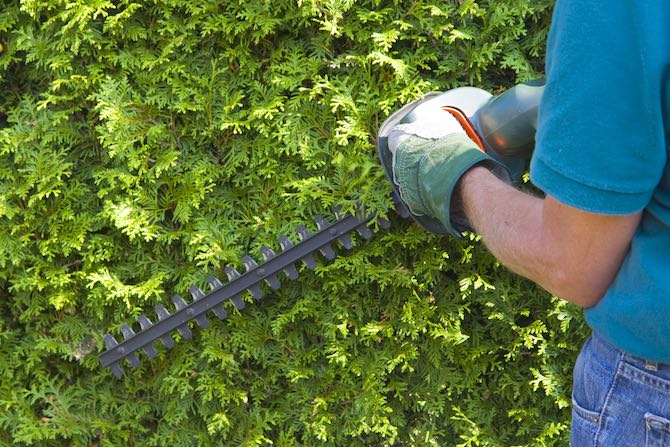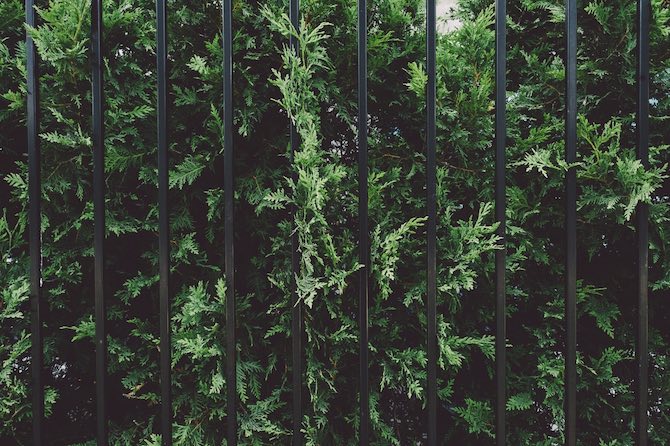Conifers are very suitable as garden dividers, as a full hedge provides enough shelter on the one hand, but is also a beautiful sight. However, it is important to maintain them by pruning them a couple of times a year. Don’t have the time or experience to do this yourself? Then you can have the conifers trimmed by a gardener or landscaper. Read in this article how much it costs, what the different options are and get useful tips on how to save.
What does it cost to prune conifers?
On average, hiring a gardener to prune conifers costs between £35 and £55 per hour. Usually, pruning a row of conifers takes half a day. Your gardener uses these four hours to make preparations, prune the conifers and then tidy everything up neatly. Check out the average cost of conifer pruning below.
| Working | Average cost (including VAT) |
|---|---|
| Conifers pruning | £140 – £ 220 |
| Conifer planting | £ 15 – £ 30 |
Find the best specialist for your project and get free quotes.
Start

Why should you have your conifers pruned?
If you have your conifers pruned it is often because the conifer has grown too tall or has many new stems with leaves. These are also called (young) shoots. It is possible that your conifers keep a nice shape of their own, but it is not wrong to prune your conifers once a year. Check out the two main reasons to prune your conifers below.
Keep the desired height
High conifers are common, with some species reaching heights of up to 10 metres. Especially if you take good care of the conifers and fertilise them regularly. Therefore, have your conifers maintained regularly, so that the conifer keeps the desired height.
Keep your conifers healthy
Priming the conifers is also important for the health of your hedge. To keep a conifer beautifully green, the entire plant must catch light. Common complaints are ‘the conifers are turning yellow’ or ‘the conifers are turning brown’.
To combat conifer discolouration, regular pruning is very important. Thinning or pruning gives the plant more air and light so that it sprouts better. Keeping a conifer hedge nice, tight and compact is not always easy. Therefore, leave this to a professional such as a gardener or a landscaper.
What to watch out for when pruning a conifer
During conifer pruning and the period after, the plants are vulnerable. To prevent the conifers from getting brown spots, you need to prune them carefully. Therefore, pay attention to the following important points when pruning conifers:
Tip 1: shave the conifers
The pruning of conifers is also called shaving. This is because it is extremely important not to cut the conifer back to the wood. If you do, you damage the conifer. By making shearing movements along the plant, only the young shoots are pruned. The young shoots withstand being cut well and shaving these will eventually make the hedge fuller.
Tip 2: Do not prune more than 10 centimetres
For the young shoots, do not prune more than 10 centimetres. This is because if you prune more than 10 centimetres, it may be too violent for the plant and damage the conifer. By pruning the young shoots, you damage the conifer hedge as little as possible. Furthermore, the pruned branches form side shoots, making the plant grow fuller.
Tip 3: the best pruning time
Conifers are champions at growing quickly at an average of 30 to 40 cm per year. The best pruning time is May or June and a second time in September. It is important not to prune the conifer later than September, as this will not give the conifer hedge enough time to recover before winter. In addition, check the branches of the conifers to make sure there are no nesting birds in the conifer hedge. This is because a dense evergreen hedge is a very popular nesting site.
Tip 4: prune on a cloudy day
Choose a cloudy, or even rainy day before having a conifer pruned. It may be less pleasant for the gardener, but wet wood allows better pruning and it keeps garden tools sharper. It also protects the plant from losing too much moisture. Especially if you have tall conifers in the garden, large cuts occur on the branches. You help the plant recover faster if the weather is not too hot.
Tip 5: Keep the conifer wider at the bottom
Conifers grow best if they get enough light and air. By keeping the underside of the conifer wider than the top, the plant catches as much sunlight as possible and they continue to grow well.
Tip 6: work with sharp tools
When pruning conifers, it is obviously important to use sharp tools. The art of pruning is knowing how and to where to cut the hedge so that cuts are kept as small as possible. This ensures a better recovery of the conifer.
Tip 7: Pay attention to your safety when pruning tall conifers
A conifer easily grows to a height of several metres. In that case, it is important to ensure the safety of the gardener in the first place. Here, make sure you have good pruning equipment with which you do not have to force any force. You also need sturdy steps and a base for the steps, so that you can prune in a stable way.

Saving tips
With a large conifer hedge, the costs are naturally higher than with a small conifer hedge. To make sure your conifers are pruned at a good price, here are some smart tips to help you save.
Combine several jobs in the garden
Do you need more garden maintenance besides conifer pruning? For example, consider cutting down a tree or maintaining your lawnby having it scarified. By combining different garden projects, you save on the total garden maintenance costs. This way, the gardener only has to come by once and you save on call-out charges.
Prepare yourself
By helping out with the gardener, he does not have to spend as much time in the garden. For example, think about tidying up the garden or taking out the rubbish. By allowing the gardener to carry out only the essential tasks, this saves on costs.
Compare different quotations
The rates of gardeners and gardeners can vary greatly, for example, one gardener may charge £35 an hour for pruning the conifers, while another may charge £55 an hour for the same conifer hedge. Therefore, always make sure you compare several quotes. That way, you will know exactly what is included in what price and you will be able to choose the landscaping company that best fits your budget.
Choose a landscaper from your region
By choosing a landscaper from your region, you will ensure that the call-out charges remain low. Some companies even charge no call-out fee at all. So pay attention to this when comparing quotes for conifer trimming.
Find the best professional for your project and get free quotes.
Start
Frequently Asked Questions
The best time to prune conifers is at the end of May or the beginning of June, but you can also have it done in the rest of June or in September. Prune no later than September because conifers need time to recover before winter arrives.
No, it’s better not to prune conifers in winter. The risk of frost damage is higher then. A good pruning time is late May or early June. To make sure the conifers look neat in winter, you can have them pruned again in August.
Browned conifers due to drought can, in most cases, recover by giving them extra moisture. When the conifers are completely dried out, it does become more difficult to restore them. Brown, bald spots caused by pruning damage unfortunately cannot be restored.